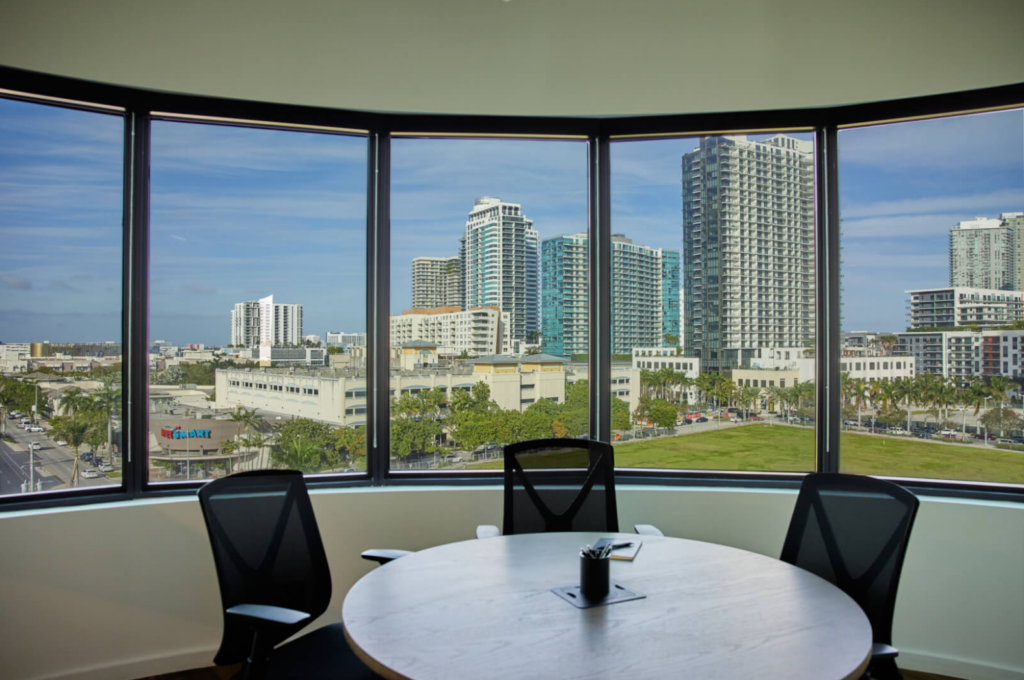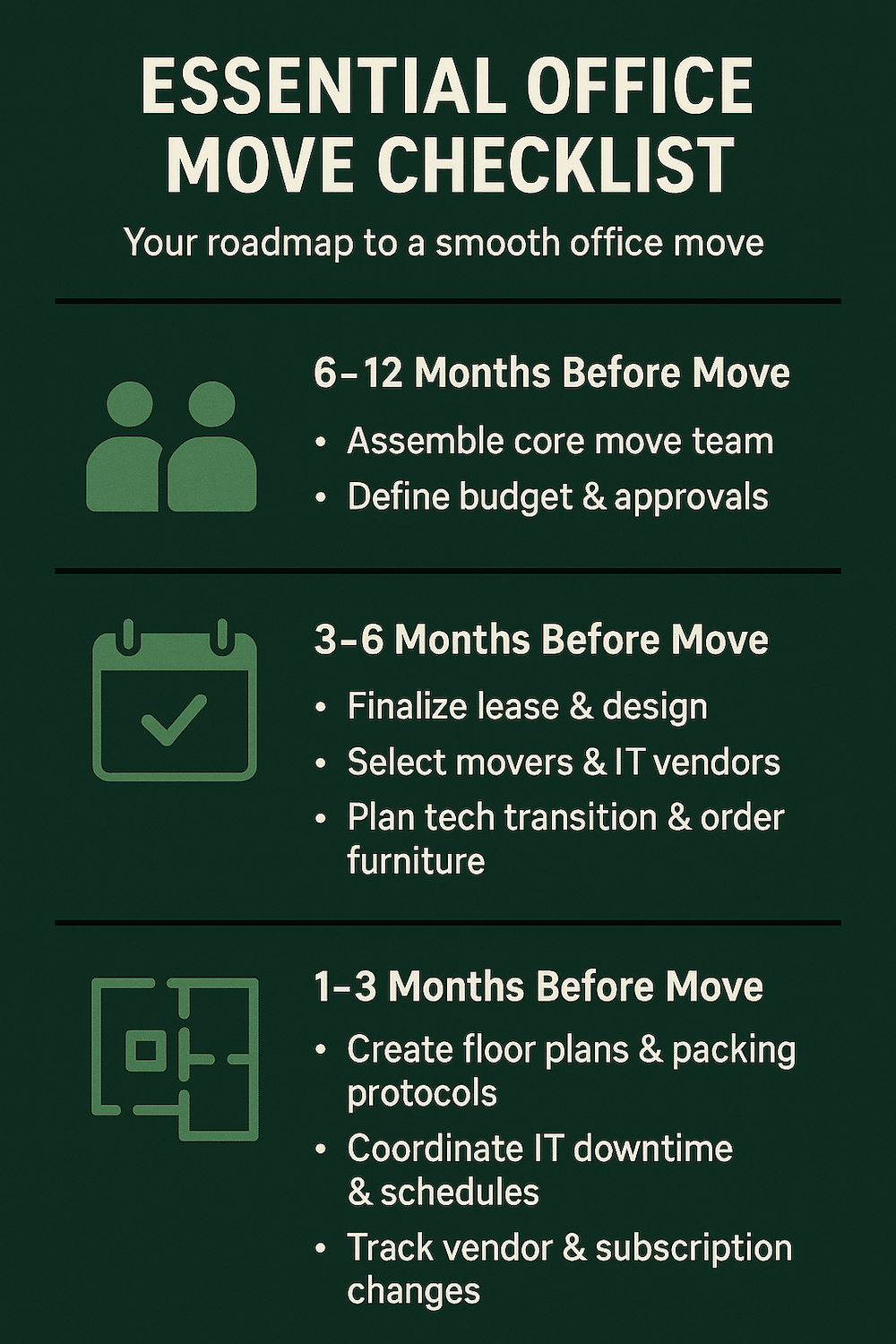
What to Consider when Planning an Office Move for 50+ Employees
Relocating an office with 50+ employees demands meticulous coordination, extended timelines, and strategic foresight. The complexity multiplies with each employee as you juggle workspace requirements, technology transfers, and human considerations simultaneously.
Your success depends on three critical elements: maintaining business continuity, managing costs effectively, and ensuring employee satisfaction throughout the transition. A poorly executed relocation can result in productivity losses, unexpected expenses, and talent attrition. With proper planning, your move becomes an opportunity to enhance your workspace and improve operational efficiency.
This guide provides essential knowledge and practical steps to navigate the challenges of relocating a substantial team. For additional insights on office relocation best practices, explore our comprehensive office relocation guide. You’ll discover critical considerations that transform a potentially chaotic experience into a seamless transition.
Strategic Planning and Timeline Development
The foundation of successful large-scale office moves lies in comprehensive strategic planning. For organizations with 50+ employees, this planning phase deserves significant executive attention and resources. The complexity of coordinating multiple departments, substantial equipment, and numerous stakeholders requires strategic oversight.
Creating Your Office Move Timeline
For offices with 50+ employees, begin planning 6-12 months before your target move date. This extended runway allows adequate time for thorough space evaluation, lease negotiations, and infrastructure planning.
The earliest phase (9-12 months out) focuses on needs assessment, budget approval, and initial space searches. The middle planning period (6-9 months before moving) includes finalizing your new location, beginning space design processes, and forming your move management team. During the 3-6 month countdown, prioritize vendor selection, detailed floor planning, and preliminary employee communications.
The final months involve intensive logistics coordination, including furniture ordering (which often requires 8-12 week lead times), technology migration planning, and detailed move scheduling. This generous timeline prevents costly emergency scenarios that plague rushed large-scale moves.
Budget Planning and Cost Considerations
Office relocations for large teams involve substantial financial commitments across multiple categories. Your comprehensive budget should account for both obvious and hidden costs. Beyond new lease terms, consider security deposits, potential building customization fees, and move-in condition requirements.
Physical moving costs scale dramatically with team size, requiring professional services with specialized equipment and multiple trucks. Technology transfer represents another major expense category, potentially including new networking infrastructure, server relocation, and workstation setup.
Build a contingency fund of 10-15% above your estimated costs to protect against unexpected challenges that inevitably arise during complex moves.
Office Space Requirements and Selection
Selecting appropriate space for a 50+ person organization requires balancing current needs with future growth potential. This critical decision impacts everything from employee satisfaction to operational efficiency and financial performance. Mistakes become exponentially more expensive to correct with larger teams.
Your space selection process should involve key stakeholders from different departments to ensure all functional needs receive consideration. Creating a formal selection criteria matrix helps objectify the process and prevent emotional decision-making.
Calculating Space Requirements
For teams of 50+ employees, accurate space calculation prevents overcrowding or wasteful excess. Begin with workspace allocation, typically ranging from 100-150 square feet per employee in traditional offices, including individual workspaces and proportional common areas.
Meeting room requirements scale with team size. A general guideline suggests one small meeting room (4-6 people) per 10-15 employees, plus larger conference rooms for team gatherings. Reception areas, break rooms, storage spaces, and utility areas must also expand proportionally.
Mindspace office solutions offer advantages for growing companies, with workspace configurations designed to maximize efficiency while maintaining professional environments. Their team suite options and space planning expertise help organizations avoid underestimating collaborative area requirements when scaling beyond 50 employees.
Location and Accessibility Factors
For larger teams, location considerations become increasingly complex as you balance commuting needs of many employees. Proximity to public transportation grows exponentially more important with team size, as parking requirements for 50+ employees can be prohibitively expensive.
Accessibility to clients, partners, and services also warrants careful consideration. Neighboring amenities like restaurants and coffee shops become important satisfaction factors for larger teams spending full days at the office.
Remember that location changes impact retention, with significant commute increases potentially triggering employee departures. This hidden cost often goes uncalculated but can represent a substantial expense through the recruitment and training of replacements.
Flexible Office Solutions for Growing Companies
Companies with 50+ employees increasingly consider flexible office solutions rather than traditional long-term leases. These arrangements offer advantages during growth phases when space needs may change rapidly.
For organizations approaching or exceeding 50 employees, dedicated team suites within flexible office environments provide privacy and culture-building benefits of traditional offices combined with scalability. Private office solutions and Mindspace’s enterprise solutions accommodate teams of 50+ employees with private entrances, branded spaces, and customized layouts while retaining flexibility rarely found in traditional office leases.
Essential Office Move Checklist
A structured checklist serves as your operational roadmap throughout the relocation process. For moves involving 50+ employees, this systematic approach prevents costly oversights and ensures all critical elements receive proper attention.
6-12 Months Before Move
Establish your core move team with representatives from facilities, IT, HR, and key operational departments. Define budget parameters and gain necessary approvals for both the move and new space commitment.
Begin your space search with clearly defined criteria, considering both traditional leases and flexible office solutions. Inventory your current furniture, equipment, and storage to determine what will transfer and what requires replacement.
3-6 Months Before Move
With space selected, finalize lease terms and begin the design process. Research and select your moving company, IT migration specialists, and other essential vendors, recognizing that quality providers often book months in advance.
Develop detailed technology transition plans, including server migrations, network infrastructure, and telecommunications systems. Begin ordering new furniture and equipment, accounting for lead times for larger orders.
1-3 Months Before Move
Create detailed floor plans showing each employee’s location and distribute departmental layouts to team leaders. Establish packing protocols and schedules, including providing appropriate materials and instructions.
Coordinate with IT to finalize technology transfer timelines, including necessary downtime windows. Confirm all vendor schedules and requirements, including building access and loading dock availability.
Begin to address change processes with vendors, clients, service providers, and subscription services. The volume of these changes for larger organizations justifies creating a dedicated tracking system.
Moving Week Essentials
Maintain a command center with key personnel available to address unexpected issues. For larger moves spanning multiple days, establish clear daily priorities and completion requirements.
Conduct systematic verification of critical systems before general employee arrival, including network connectivity, security access, climate control, and essential services. Consider staggered arrival schedules to prevent simultaneous troubleshooting demands.
Technology and Infrastructure Considerations
For organizations with 50+ employees, technology infrastructure represents one of the most complex aspects of relocation. The interdependent nature of modern business systems requires extraordinary care to prevent operational disruptions affecting dozens of employees simultaneously.
IT Systems Migration Planning
Map your entire technology ecosystem, including servers, networking equipment, specialized hardware, and connectivity requirements. Create a detailed inventory with dependencies clearly identified to prevent critical oversights.
Evaluate connectivity requirements at the new location well in advance, as higher-capacity business connections often require significant lead time. For teams of 50+, redundant internet connections from different providers offer important protection against outages.
Consider whether the move provides strategic opportunities to upgrade systems or migrate to cloud-based alternatives that reduce physical infrastructure requirements.
Data Security and Backup Protocols
Establish comprehensive data protection protocols specific to the moving process. Beyond standard backups, consider creating dedicated pre-move system images that can be rapidly deployed if migration issues occur.
Document your security and backup procedures to demonstrate due diligence in protecting organizational and customer data throughout the transition. Create specific protocols for secure disposal of equipment and documents not transitioning to the new location.
Employee Communication and Change Management
The human dimension of office relocation often determines ultimate success, particularly for larger organizations where coordinating dozens of individuals creates significant complexity. Effective change management transforms potential resistance into engagement and prevents productivity losses.
Developing Communication Strategies
Create a comprehensive communication timeline that begins with general announcements and progressively provides more detailed information as the move approaches. Utilize multiple communication channels including team meetings, dedicated intranet pages, email updates, and visual displays.
Establish feedback mechanisms allowing employees to ask questions and express concerns throughout the process. Consider department-specific feedback sessions addressing unique requirements of different functional groups.
Managing Employee Concerns and Resistance
Proactively identify potential resistance points by analyzing commute changes, workspace adjustments, and alterations to daily routines. Address concerns directly rather than hoping they’ll resolve themselves.
Involve employees in appropriate decision-making processes where possible, such as common area configurations or department layouts. This participation builds ownership and reduces resistance while often generating practical improvements.
Minimizing Business Disruption
Consider phased moving approaches where departments relocate sequentially rather than simultaneously. This strategy maintains partial operational capacity throughout the transition while allowing support resources to focus on smaller groups each day.
Identify your truly critical business functions and develop specific continuity plans for each. This might include temporary duplicate systems, designated emergency response teams, or arrangements with partners who can provide backup capabilities.
Create clear decision-making authority for addressing unexpected challenges during the move itself. Establishing who can make real-time decisions about schedule adjustments prevents costly delays.
Click to book your office space with Mindspace, leave us a note here
Frequently Asked Questions
What constitutes a large office move?
Office relocations involving 50 or more employees typically qualify as large moves due to their operational complexity and business impact. These moves require more extensive planning timelines, dedicated project management, and specialized vendor support.
What is phased moving, and when should it be considered?
Phased moving involves relocating your office in sequential stages rather than all at once. This approach becomes particularly valuable for organizations with 50+ employees or those with critical continuous operations, as it maintains partial functionality throughout the transition.
What are flexible office solutions for growing companies?
Flexible office solutions provide professional workspace environments without long-term lease commitments or substantial capital investment. These options include dedicated team suites and private office spaces from providers like Mindspace that offer privacy and culture-building benefits combined with the ability to scale space as your team size changes.







